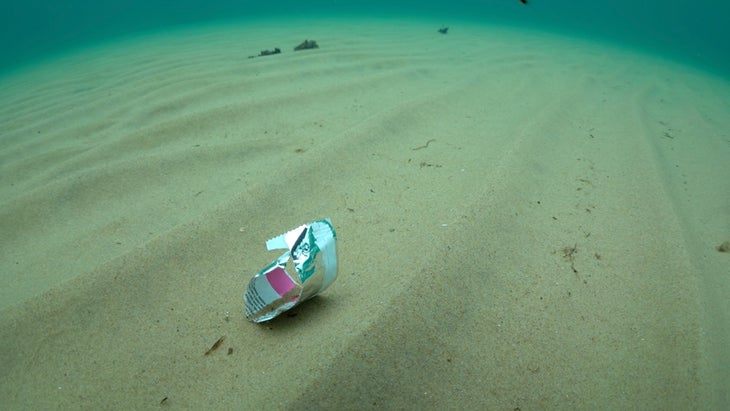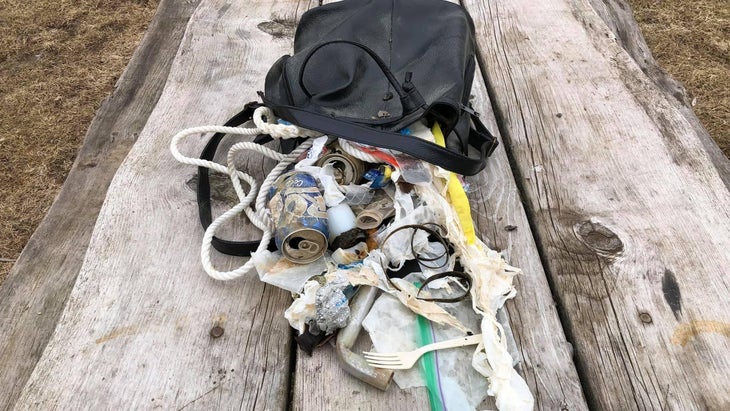“My girlfriend tells me I smell like trash,” says Colin West. And he takes that as a compliment.
West spends 40 to 60 hours a week scuba diving Lake Tahoe to locate and remove submerged trash. On the day I spoke with him, he and a group of divers had collected 576 pounds of underwater garbage, including a massive monster truck–style tire. And since launching the nonprofit Clean Up the Lake in 2018, West and his team of ten full-time employees and contractors, plus an army of trained volunteers, have picked up more than 18,000 pounds of refuse.
Their latest mission? To complete the first circumnavigation of Lake Tahoe via scuba diving, with each dive focused on removing waste. As the nonprofit’s founder and executive director, West dives for trash three days per week, ten to 12 hours each dive, alongside a crew of Clean Up the Lake employees and volunteers.
The group’s Tahoe initiative launched in 2020; it’s supported by local sponsors like Tahoe Blue Vodka and the Tahoe Fund and will cover the waterway’s 72-mile circumference. It’s among the largest litter-removal efforts ever for the lake, and it couldn’t come at a better time. While lauded for its bright-blue beauty, Lake Tahoe’s deep-water clarity has plummeted by 30 percent from 1968 to 1997, according to the EPA. In 2019, scientists also found microplastics in Lake Tahoe’s water for the first time—a fact that’s particularly troubling given that the lake is a major drinking water source for Nevada communities.
Even with forces out of their control—the 221,000-acre Caldor Fire in fall 2021 and severe droughts impairing water access—West anticipates his crew will complete the circumnavigation this December. Along the way, Clean Up the Lake has done much more than rid Tahoe of litter. West is giving legs to a budding “give back while getting outside” movement: trash diving. (Think plogging but fully underwater.)
Trash collection isn’t new to the world of scuba. Since 2011, divers have removed more than 2 million pieces of marine debris through the Professional Association of Diving Instructors’ (PADI) Dive Against Debris program, a global scuba initiative to remove and log submerged litter, says Kristin Valette Wirth, PADI chief brand and membership officer.
In recent years, though, diving for waste has expanded inland to the country’s best-loved yet increasingly polluted lakes. West alone has received approximately 600 applications from interested scuba volunteers around Lake Tahoe. The Great Lakes also have trash divers tackling the region’s growing water-contamination concerns. These lakes, which make up more than 20 percent of the planet’s surface freshwater, are polluted with 22 million pounds of plastics each year, largely from local watersheds and shorelines.

Lake Tahoe and the Great Lakes may lack the colorful corals and enchanting marine life of the oceans, but these under-the-radar dive locales offer two main allures: mind-blowing geology and rarely seen shipwrecks. The Great Lakes alone boast more than 6,000 sunken ships.
“We have the best shipwreck diving in the whole world, hands down,” says Chris Roxburgh, one of the Great Lakes’ best-known divers. Roxburgh, a master electrician in Traverse City, Michigan, reached local diving fame through his jaw-dropping photos of Great Lakes wrecks. This fall, he appeared on the History Channel’s Cities of the Underworld to share this wreck beauty with the world.
Social media helps Roxburgh and dozens of area divers showcase the hidden wonders of Great Lakes scuba while illustrating the severe plastic plight lurking below the surface. Roxburgh’s home waterway, Lake Michigan, receives roughly half of all of the Great Lakes plastic pollution. With everything the Great Lakes have given him, both recreationally and professionally, Roxburgh now feels responsible for protecting and future-proofing these waterways. He shares footage of submerged Mylar balloons, wrappers, toys, and soda cans to inspire followers to get involved.
“Since I was a kid, my parents taught me to leave no trace and clean up trash along the beaches and underwater, so it’s something I’ve been doing my whole life,” he says, noting that local wreck-diving fame has given him a platform to fight for the lakes he loves. “I felt like I needed to put [content] out there to show people they can make a difference. Especially scuba diving. We get the trash people can’t get to.”

Some area divers, like “Diver Don” Fassbender of Great Lakes Scuba Divers and Lake Preservation Club, host trash-diving meetups in Michigan’s Upper Peninsula. But Roxburgh typically goes with a small, hand-selected group, due largely to the liability and dangers, which are increased by the often-required clunky drysuits.
“If you don’t do it properly, your trash bag can get snagged, and it can become entangled in your equipment,” Roxburgh says. “The main thing is to not collect too much to the point it makes the dive unsafe. Always have a plan on how much you’re willing to collect safely, and don’t have ropes or strings floating about.”
Diving Lake Tahoe comes with its own unique risks. It’s the second-deepest lake in the world (1,600 feet) and sits at an altitude of around 6,200 feet above sea level. These elements make for tricky dive safety, and that’s before adding the variable of collecting garbage. West says Clean Up the Lake requires volunteers to have “at least advanced open-water certification with five recent dives.” Each new volunteer goes through rigorous preparation. So far, his team has selected and trained just under 100 volunteers.
“They need to be comfortable when working in a team underwater, because we’re down there working,” he says. Each team of divers—two scuba, one freediving near the surface—follows GPS coordinates. The scuba divers take mesh bags to pick up small trash along the way and use custom hand signals with the freedivers if they stumble upon something heavy that requires a weighted rope system.
Then there’s the fact that they’re diving well beyond summer to meet that December 2021 goal. “The winters get f-ing cold, and the lake gets really cold, even in a drysuit,” West says.

Divers alone aren’t going to clean up 22 million pounds of Great Lakes plastic. And a 72-mile circumnavigation may rid Lake Tahoe of debris—they’ve already removed 8,000 pounds of trash through this circumnavigation initiative—but it’s not going to fix the main Tahoe pollutants: fertilizers and urban stormwater runoff.
Is the risk of trash diving worth the reward? Yes, says Meagen Schwartz, who studied environmental science at Indiana University and founded Great Lakes Great Responsibility (GLGR), a volunteer movement to de-litter the region’s coasts and waterways. GLGR’s newest push, the #GreatLakes1Million challenge, calls on area residents to gather and record litter, then share their work on social media to catalyze local communities. The goal is to pick up 1 million pieces of waste; they’ve collected 90,000 since November 2020.
Schwartz lives in Alpena, Michigan, home to one of the region’s most vibrant dive spots: Lake Huron’s Thunder Bay National Marine Sanctuary, which boasts nearly 100 historic shipwrecks. While she doesn’t dive herself, Schwartz says trash divers have been instrumental not just to her movement, but to the plastic problem plaguing waterways around the world.
“They’re on the front lines. They’re seeing what’s in the more benthic region [the bottom] of the lake,” Schwartz says. “It’s also about raising awareness about the plastic problem. People can make individual changes, but it really needs to come from putting different legislation in place.”
Schwartz plans to use those 1 million pieces of inventoried trash to fight for change upstream, including data-driven petitions for new, more sustainable legislation. West hopes to do the same; Clean Up the Lake already has hard data from more than 80 categories of collected trash to showcase main pollutant sources and systemic problems.
Making real change is no pipe dream, and PADI’s Dive Against Debris program is proof of that. Take the small island nation of Vanuatu in the South Pacific as a case study. In 2018, Vanuatu decided to ban nonbiodegradable plastic bags, largely based on Dive Against Debris data. The trickle-down effect was monumental.
“Vanuatu no longer required bags to be shipped there, reducing the country’s overall carbon footprint,” says PADI’s Valette Wirth, noting the removal of plastic bags sparked the need for new, sustainably made sacks. Through this community-driven microeconomy, Vanuatuan people created bags using banana and palm leaves. “Due to the success of the policy decision, Vanuatu became a champion country promoting international cooperation to tackle marine debris. This is living proof of how local action can have a global impact.”
